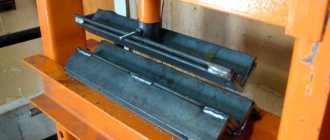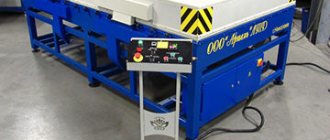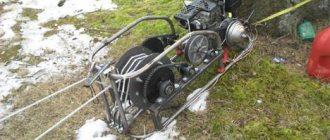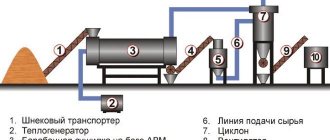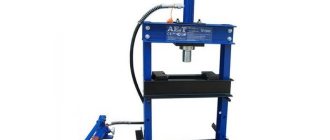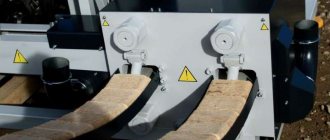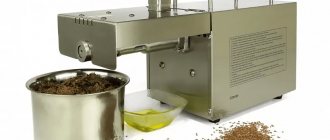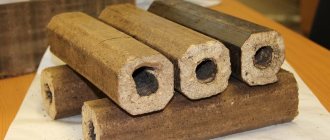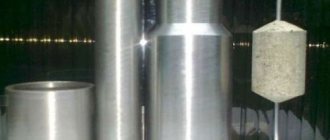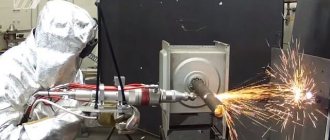In some situations, owners of private houses may need a pressing device with an impressive pressure indicator. Buying such a tool is irrational, since it requires significant financial investments, and the device will not be used so often.
This article will discuss the drawings of a hydraulic press and describe the algorithm for its manufacture at home.
Mechanical type of unit
The most common presses made at home are:
- Mechanical presses
- Hydraulic presses
These types of tools are best suited for use at home or in the garage as they take up little space.
This type of installation is quite popular due to its small dimensions. You can make a mechanical press of any mode (automatic or manual) with your own hands. The simplicity of the design ensures its reliability and provides good resources.
An approximate model of a mechanical press made by yourself can be seen in the photo on the Internet.
A mechanical press is capable of processing:
- Cardboard
- Rubber
- Plastic (and other polymers)
- skin
- Metals
What is needed to make a press
The drawings of such a device allow you to make a press from a jack with your own hands. They are easy to find on the Internet in the public domain.
Drawing of a homemade press from a hydraulic jack
To make a hydraulic press from a jack, you should also prepare:
- the hydraulic jack itself is of a single-rod bottle type (for a press that will be used at home, a jack that develops a force of up to 10 tons is also suitable);
- inverter with a set of electrodes;
- hacksaw for metal;
- grinder with a set of discs designed for cutting metal;
- a section of channel size 8 and above, 4 m long;
- square or rectangular profile pipe with thick walls;
- equal-flange metal corner No. 50;
- steel strip having a thickness of more than 10 mm;
- a piece of pipe 10–15 mm long, the diameter of which should match the size of the jacking rod;
- metal plate measuring 25x10 cm and thickness 9–10 mm;
- two springs that are needed to return the stop to its original position (springs from car seats, doors, etc. are suitable).
Channel blanks
Jack and its features
The press is based on the mutual work of two cylinders of different sizes. From the chamber that has a smaller size, with increasing pressure, the liquid is transferred to a chamber with a larger size.
The interaction of these cylinders with pistons having different diameters constitutes the work of the structure. In this way a strong pressing effect can be achieved.
A version of a homemade garage press can be seen in the photo on the Internet.
To make a hydraulic press, a glass jack is most often used. It has a relatively low cost and is capable of producing a pressure of 20 tons.
There are two ways to assemble a jack-based hydraulic press in your garage:
- Position of the jack at the base of the mechanism (pressing upward)
- Position of the jack at the top of the mechanism (pressing down)
Jacks have a parameter for the correct position. Some jacks cannot be used in an inverted position. Therefore, before starting work, you need to make sure of the capabilities of the selected equipment.
Specifics of a hydraulic jack
It was not by chance that a hydraulic jack was chosen as the basis for the construction of a homemade press.
An important feature of this device is that its operation is based on the fundamental laws of physics, according to which a liquid under pressure does not compress or decrease in volume. This explains why there is no loss of power when the jack is applied to the workpiece.
In addition, the hydraulic jack has a fairly high efficiency (80%), which allows you to count on significant compression force in the case of a power press.
Necessary materials
To make a press, prepare:
- channel P-14;
- pipe 40*40 mm round or square section;
- corners;
- steel sheets (optimal thickness - 7 - 8 mm);
- centimeter thick metal plate;
- a piece of pipe measuring 10 - 15 cm.
Structural design and assembly features of the vacuum model
The design of the vacuum-type model has certain specifics, which it is advisable to study in advance. Preliminary familiarization with this information will allow you to better understand how to build such equipment.
Looking at the pictures of a vacuum-type hydraulic press, we can distinguish three basic units:
- Bed or frame.
- Working surface.
- Pneumatic system.
The model under consideration has the following structural nuances:
- The tool is designed for manual operation.
- Assembling the press does not require the use of any unavailable materials or complex devices.
- In terms of efficiency, do-it-yourself hydraulic manual presses do not differ from industrially assembled equipment.
Blueprints
Before starting work on creating a hydraulic press, it is strongly recommended to draw up a drawing. The dimensions of all parts of the structure must completely coincide, otherwise the first time you use the unit, the structure will move to the side.
Experts recommend that you independently draw up a drawing of the future system, since ready-made options will not always satisfy the owner in terms of dimensions, and you can also make a mistake in choosing the type of jack. In this case, a lot of time will be lost to adjust the system to its parameters.
Photos of hydraulic press drawings can be easily found on the Internet.
Step-by-step instructions for creating your own hydraulic pressing equipment.
One of the main actions associated with making a hydraulic press with your own hands is preparing the frame. It has the name “bed” and it is inside it that the future press will be located. Its strength must have some reserve, since the pressure inside the frame is carried out in both directions (up and down), so there is a possibility that the frame will break.
The first thing you need to do is cut all the main parts of the structure according to the drawing data. You need to drill holes in the structure. Next, a special plate is installed by welding.
How to calculate parameters and make a mechanical press
Mechanical devices are needed to process leather and metal products. They can also be used to recycle cardboard boxes and foam.
Here are instructions on how to make a mechanical-type hydraulic press yourself:
- Cut the steel corner into 4 pieces of 90 cm each and weld to 4 corners, 55 cm long. You should get two metal rectangles
- Secure them with steel pipes.
- Strengthen the made box using crossbars and steel plates.
- Organize a small gate in one of the walls to remove processed parts.
- Start forming the piston. For this purpose, weld channels measuring 55 - 65 cm together. Reinforce the workpiece with a steel cross member, attach a flange to its middle, into which insert a metal rod ahead of time. Next, weld the channel structure to the previously made box.
- Place a washer with a nut and a bearing on the rod.
Manufacturing process
Press frame
The material for the frame, its structural strength and the method of assembly should be determined by the pressure that the jack is capable of delivering. For accurate calculations, it is important to understand in which direction the loads act during operation.
The base of the press is a rectangular U-shaped frame made of a channel or a paired steel angle. The main acting force is the resistance to compression, expressed in concentrated load. The main force is concentrated in the centers of the horizontal crossbars. The forces that stretch the vertical racks of the press and the phenomena of deformation in compressed parts can be completely neglected.
1 - upper thrust beam; 2 - bolts; 3 - jack 20 t; 4 — return springs; 5 - movable beam; 6 — locking pin; 7 - adjustable support beam; 8 - transverse beam; 9 - legs from corners
For installation with a compressive force of up to 5 tons, you can safely use the following to make a frame:
- Channel according to GOST 8240–89, standard size 8P.
- A pair of hot-rolled angles according to GOST 8509–93, size 50x5 mm, connected with 10 mm rods every 20–25 cm, or with a solid weld.
Channel dimensions 8P
Let us immediately make a reservation that we provide approximate data on rolled metal for a frame with an internal window no wider than 100 cm. By analogy, when using a jack with a force of up to 10 tons, the frame should be made from:
- Channel size 10P.
- Twin angle steel 63x7 mm, solid seam connection with internal inserts of nominal cross-section.
Channel dimensions 10P
If the required compression force reaches 15 tons or higher, then the frame should be made of:
- Channel size 14P.
- Twin angle 75x8 mm, connection similar to the previous one.
Channel dimensions 14P
The above proposal for rolled metal products implies a tenfold safety margin, which completely eliminates exceeding the limit of elastic deformation and is normal for installations of this kind. All frame joints must be welded with solid double-sided seams and butt cut. If the connection is not made by welding, assembly with bolts or cotter pins is allowed. In this case, it is necessary to take into account the maximum permissible shear load.
With a bolted connection, the main load becomes dispersed and the compression force of the press must be divided by the number of bolts or pins. The destructive shear force of bolts made of the most common steel ST-3 is:
- M10 - about 2500–3000 kg.
- M12 - 4000–4500 kg.
- M14 - 5500–6000 kg.
To ensure the required safety margin, each fastening element must experience a load five times less than the destructive load. For steel fingers, the force can be taken 10–15% higher than the specified values. If the required number of fasteners cannot be placed in a corner unit, you should increase the strength with gussets, for which it is preferable to use corner steel instead of sheet steel. The same applies to the welded frame structure, which also helps to avoid the use of excessively massive rolled steel.
In addition to the loaded upper part, the frame includes two racks with legs that provide the press with sufficient stability, and a cross beam that can be adjusted when processing parts of different sizes.
The cross-section of the upper and lower beams must be equivalent, as well as the cross-section of their fastening elements. Everyone is free to implement the legs and support according to their own considerations; they do not experience work loads in addition to the own weight of the press. The only requirement is the presence of a bottom crossbar, which gives the structure additional rigidity.
Adjustable support beam
As you already know, the lower beam must have a cross-section no smaller than that of the upper one, but it differs in design. The support table is made of two channels, with the ribs facing outwards, which are placed on opposite sides of the racks and welded in the central part with inserts from angle or thick reinforcement.
There is free space along the center of the beam, which explains the need to make a lower support block. The latter should rest on at least half the width of each shelf; the shear stops are welded in the center of the lower part.
The best option for fixing the beam to the racks is with the help of massive steel pins. To do this, a series of round notches at different heights with a parallel arrangement should be made in the vertical channels of the frame. As you understand, the diameter of the pins cannot be less than the total cross-section of all the bolts used to fasten the upper part of the frame.
Return mechanism
The last part of the homemade press design is a spring mechanism that will fold the jack when the bypass valve is open. For this purpose, ordinary springs for finishing doors are suitable, which can be purchased in unlimited quantities at any hardware store.
The task is complicated when using an upper headstock, the significant dead weight of which will not allow the springs to compress. Alternatively, you can increase the number of springs to four or six, or use more powerful extension springs for the gate.
If there is no upper block, it is necessary to secure the springs to the jack rod. To do this, you will need a washer, the internal hole of which is larger than the rod adjusting screw, but smaller than the diameter of the piston. The spring is attached to it through two small holes along the edges and fixed to the top beam in the same way or on welded hooks. It is not necessary to position the spring strictly vertically; you can compensate for the excess length with an inclined position.
Advantages of a removable stop
The removable stop allows you to transfer the direction to the component as it moves along the guide.
To make it, purchase sections of profiles 10 mm thick and slightly shorter than the distance between the posts. All you have to do is weld the stop to the two posts.
Homemade press from a jack is a reality. To create it you will need skills in working with a welding machine and desire.
Additional settings
When using a homemade hydraulic press, users often have a question about how to make the jack rod move a shorter distance. This will allow you to spend less time processing parts using a homemade press. There are several ways to solve this problem.
- A rectangular or square profile pipe is mounted on the lower fixed stop of the press (either a removable version or fixation using a welded joint is possible).
- A height-adjustable lower stop is installed on the press, which is fixed to the side posts of the device with bolts. To install such a stop at different levels, holes are made in the side posts of the press at the required height.
- The distance between the press stops can also be reduced by using replaceable pads or anvils installed on the surface of the lower stop of the equipment.
How to make your own hydraulic press with electric drive
Equipment such as an electro-hydraulic press, due to its versatility and high efficiency, is actively used both in large manufacturing enterprises and in small workshops, as well as at car service stations. Using a hydraulic press equipped with an electric drive, you can solve many technical problems, which include:
- pressing, pressing out of gears, bearings and shafts;
- stamping, straightening and bending of metal products;
- pressing of products made from wood shavings, plastic and metal.
The electro-hydraulic press R-342M is intended for performing work on pressing, straightening and pressing in repair shops
A serial electro-hydraulic press will be quite expensive, but you don’t have to buy it, but make it yourself.
Serial hydraulic presses with electric drive are quite expensive, so it makes sense to think about how to make an electro-hydraulic press with your own hands. To do this you will need the following tools and equipment:
- welding machine;
- lathe;
- drilling machine;
- Bulgarian;
- electric drill.
This press will be able to produce a maximum pressure of 35 tons
The supporting structure of the electro-hydraulic press, which is subjected to the main mechanical loads, is the frame, the strength of which should be given special attention. A T-beam made of metal of such thickness that it can withstand the loads created by a hydraulic press without bending is well suited for these purposes.
Press frame made of I-beam
Structurally, the frame of a homemade electro-hydraulic press is a U-shaped frame, welded from T-beams and installed on a base, for the manufacture of which thinner channels and angles can be used. In the middle part of such a frame (along its height), a working platform is welded into it, for the manufacture of which thick-walled channels are used.
Particular care should be taken when attaching the hydraulic cylinder to the frame of a homemade electro-hydraulic press. In order for such fastening to be as reliable as possible, it is better to fix the hydraulic pump on a 20 mm metal plate using a flange. The metal plate itself, which will absorb all mechanical forces, is mounted on two T-beams.
The rigidity of the structure is ensured by high-quality welding seams
The process of installing a hydraulic cylinder on the frame of a homemade hydraulic press is carried out in a certain sequence.
1. Adjustment of hydraulic cylinder, flange and plate
The body of the hydraulic cylinder, so that it can be placed in the inner part of the flange, is turned on a lathe.
The flange, which can be made from a car hub, is also processed on a lathe.
In order to make a hole in a metal plate that will be used as a base for installing a hydraulic cylinder, it is necessary to weld a round boss to it. With the help of the latter, such a plate will be fixed in the lathe chuck.
20 mm thick plate with a welded boss in the center
After the hole in the slab is bored out, it is welded to the beams of the base frame.
The flange, in which the mounting hole has already been prepared, is put on the hydraulic cylinder and welded in a circle.
Flange welded to hydraulic cylinder
It is very important that the flange and hydraulic cylinder are connected as smoothly as possible; for this, the adjacent surface of the flange must be machined on a lathe. 2. Installation of upper beams and hydraulic cylinder
The plate, which is already connected to the beams, is installed on the frame and connected to it by welding.
Through the holes on the mounting part of the flange, holes are drilled in the plate, which are necessary for placing the mounting bolts.
The installation of the upper beam is carried out strictly perpendicular to the supports
The hydraulic cylinder should not be attached to only one point, so it is necessary to make another flange, put it on the top of the cylinder and weld it to the beams.
Installing the Top Flange
T-beams installed in the upper part of the frame are connected to each other by welding.
3. Installation of the frame and oil station
In order for the hydraulic press you have made to fully function, you need to install an oil station on it and connect it with a hydraulic cylinder using hoses.
Installation of a frame and a two-flow hydraulic station delivering a pressure of 700 bar
Thus, it is not difficult to make a hydraulic press with an electric drive with your own hands. At the same time, you will have at your disposal equipment that can solve many technical problems.
Types and scope of application
Both home-made and mass-produced hydraulic presses are classified according to several parameters:
- sizes;
- maximum force produced;
- design features of the equipment (in particular, the height of the rod).
The most powerful are hydraulic presses related to floor-type equipment. A hydraulic floor-type press, distinguished by significant dimensions, is capable of creating pressure at one point, the value of which can reach tens of megapascals. The scope of use of equipment of this type, which can be equipped with additional devices, is quite wide. Floor hydraulic presses are necessary to solve such technical problems as:
- installation and removal of bushings, shafts, bearings;
- pipe bending;
- pressing of products made from various materials, including metal.
Some models of floor-type electro-hydraulic presses provide the ability to change the height of the work table.
Electro-hydraulic press 2135-1M, force 40 tons
Tabletop hydraulic presses, along with their small size, are characterized by less power. The pressure created by such equipment, installed on a desktop or workbench, rarely reaches 20 tons. The compactness of tabletop electro-hydraulic presses allows them to be used in small automobile and home workshops.
An important parameter of electrohydraulic presses, in addition to the force they are capable of creating, is the height of their rod. This parameter, in particular, determines what size parts the equipment can work with. If for tabletop presses this parameter can reach 100 mm, then for floor-standing models it reaches half a meter.
Due to their versatility, electrohydraulic presses are used in many fields of activity. Such areas of activity, in particular, are mechanical engineering, woodworking and food industries. However, most often such equipment can be found at vehicle repair stations. Using it, you can successfully solve not only all of the above technical problems, but also straighten dents and other damage to the car body. Unlike pneumatic equipment, the use of which requires a rather complex pneumatic system, a hydraulic press with an electric drive can simply be connected to an electrical power supply, and it will function normally.
We create a press with electric drive
To make a power press, you will need an electric motor. Let's consider an approximate sequence of actions:
- Make a frame from 2 guides made from square steel pipes.
- Drill holes in the pipes to attach the platform.
- Create a “lift” to allow the press platform to move (use steel angles).
- Make a pressure platform using a high-strength channel.
- Install the jack and connect a pedal to the structure to control the power of the pressing device.
Useful tips and general recommendations
When manufacturing a structure, the edges of the workpieces should be processed with an abrasive tool, removing burrs. To prevent the bolts from gradually loosening, it is necessary to install spring washers (grovers) or use self-locking nuts used in the automotive industry.
If, after the first use, warping of the top crossbar or table is detected, then jumpers should be installed from a profile with increased strength (for example, with increased thickness or made from a different type of steel).
When installing an electric drive or control panel on the frame, the operator must be protected from electric shock. The wires must be routed in corrugated sleeves outside the movement area of the crossbar.
The presence of a grounding line and an RCD unit in the distribution panel provides additional human protection. Electrical equipment is extremely dangerous; during operation, it is strictly forbidden to adjust or hold parts with your hands.
To press or remove bearings, use mandrels made of aluminum or copper alloy. Direct force on the rings leads to destruction of the part.
Before installation, you should make sure that the wheels are in the correct position relative to the hole in the housing or shaft, and then carefully pump oil into the working cavity of the jack. Similar rules apply to the installation of rubber-metal silent blocks used in car suspension arms.
The nuances of making a mini-pressing device
Many craftsmen give their preference to small-sized designs. Such people will certainly like the mini-press, which offers a desktop installation method.
Such a device is easy to manufacture, but it is rarely used due to its low practicality. For example, it is used if you need to chop walnuts or compress containers made of tin or plastic.
The frame of the mini-press is assembled from durable lumber. A rectangular frame is made from 4 boards. A mobile wooden pressing surface is installed in its upper part. The hydraulic system is made from standard medical syringes.
Home use options
Use a hydraulic press if necessary:
- squeeze the metal part out of the shell;
- press out or compress the bearing or rubber-metal hinge;
- straighten an element or connect two products end to end;
- bend any piece of metal.
The device is also suitable for producing fuel briquettes used to light the stove. The advantage of using compressed sawdust is long-lasting combustion and the absence of smoke formation, as well as the creation of intense heat.
To form briquettes from coal chips, you will need to slightly change the mechanism. The main parts of such a press will be the work table, base, bed and drive.
Excellent results are achieved by using pressing equipment for recycling plastic bottles and cans. It easily transforms containers into neat layers.
The hydraulic type device can be adapted for a hay pick-up. To do this, you need to supplement it with a cobblestone or steel frame without an upper fragment. Using special fasteners, this structure must be attached to the front. You will also need a transport pick-up and a running element.
